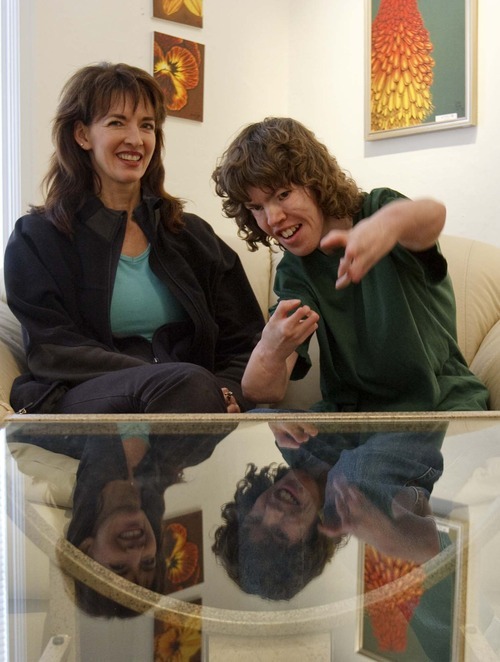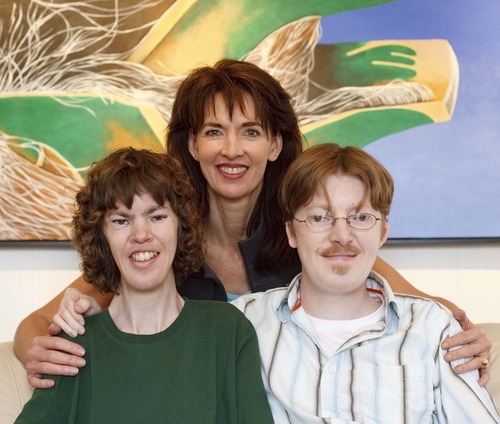This is an archived article that was published on sltrib.com in 2010, and information in the article may be outdated. It is provided only for personal research purposes and may not be reprinted.
Debbie Jorde's first baby emerged from the birth canal silent and still.
"Was she breathing? I couldn't tell," recalls Jorde, whose panicked heart was momentarily soothed by gurgling sounds and muffled cries.
"Then I saw her arms; really saw her arms.
"Something was wrong. These were not normal arms; not normal hands.
"Now I was the one struggling to breathe."
So begins Jorde's new memoir recounting the challenges of raising two children with a rare, disabling disorder known as Miller syndrome. Jorde's children, 33-year-old Heather and 30-year-old Logan, are among only 30 people worldwide who have been diagnosed with the hereditary condition, characterized by facial and limb malformations.
Eight Fingers and Eight Toes: Accepting Life's Challenges charts Jorde's initial shock and her coming to terms with her children's very visible, but poorly understood, medical conditions. She shares wisdom accumulated from outlasting an assault of medical complications, surgeries and visits to specialists. Woven through the main narrative are candid passages on divorce, single motherhood and Jorde's three-year battle with an eating disorder.
"I hope others learn that by accepting themselves and their challenges, they can find more happiness and experience more success," said Jorde, 55. "I hope they can feel more empathy and compassion and less fear when they see someone who looks or acts differently than they do."
What inspired you to write this book, and how did you find the time?
Twenty-three years ago, I recognized that I had gained valuable insights while raising Heather and Logan and overcoming my own personal challenges. I realized that if I died, the information would die with me, benefiting no one.
At that time, Heather and Logan had undergone over 40 surgeries and I had experienced bankruptcy and divorce, losing my husband, my home and my security. I was self-employed as a hairstylist but resolved to write my story as soon as the time felt right.
Twelve years later, after I had remarried and Heather and Logan had graduated from college and were living in their own apartments, I committed to write no less than 15 minutes a day.
I finished the first draft, then put it down for another four years to help Logan gain self-employment as an artist. He was struggling with depression and chronic pain. Later, Logan and Heather were both diagnosed with autism spectrum disorder.
Then came the adventure in 2007 of buying a small house and remodeling it into a hair salon and Heather's hospitalization with life-threatening pneumonia.
I came back to my book last year. I hired an editor and self-published because I wanted Heather and Logan to benefit from it while they were both stable and healthy.
How did you muster the courage to share such intimate family moments?
My openness started out unconsciously as therapy. I felt better when I communicated what was going on in my life. I didn't feel so alone.
When Heather was born with all her visible problems, my first reaction was denial: "This isn't happening. I don't want this baby. I want to go home and pretend like this was just a bad dream." I felt ashamed and wanted to be honest about it so that other parents who may experience this know they are not terrible for thinking such things.
How would you describe the act of writing?
Writing is like exercise. It's hard to begin, but once you get started, it gets easier. At first, I made a lot of mistakes. I wrote passively and reported events rather than showing them.
It took a lot of self-discipline. When I was writing about difficult experiences from my past, I felt as if I were reliving them. I had to remind myself that these were different times; that I was safe and secure, and that things are better.
What have you learned from Heather and Logan?
I have learned the value of seeing past the way a person's body looks. I have learned respect for people for doing their best, even when their best doesn't look like mine or someone else's. I have learned to embrace diversity. In order to do this, I first had to learn to love myself and accept my own shortcomings, even laugh at them. I have learned humility. I have watched Heather and Logan find value in their lives. I have watched them adjust their expectations and persevere though their disappointments. This is an ongoing process for them and for me, too.
Meet the author
Debbie Jorde and her two children, Heather and Logan Madsen, will hold a book signing on Saturday, Dec. 11, from 3 to 5 p.m., at Art Access Gallery, 230 S. 500 West, Salt Lake City. For more information, visit Jorde's blog at http://www.debbiejorde.com. —
Postscript
Earlier this year, Debbie Jorde and her children, Heather and Logan Madsen, became the first family in the world to have their entire genome sequenced. University of Utah researchers discovered the family had changes in two genes: the Miller syndrome gene and another gene for lung disease. This explained the Madsens' unusual chronic lung disease, which isn't a feature of Miller syndrome.





